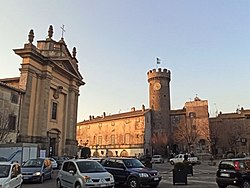Bagnaia | |
|---|---|
 Piazza XX Settembre in Bagnaia | |
| Coordinates: 42°25′41″N12°9′18″E / 42.42806°N 12.15500°E | |
| Country | Italy |
| Region | |
| Province | Viterbo (VT) |
| Comune | Viterbo |
| Elevation | 441 m (1,447 ft) |
| Population (2017) [1] | |
• Total | 5,500 |
| Time zone | UTC+1 (CET) |
| • Summer (DST) | UTC+2 (CEST) |
Bagnaia is a village in Lazio, central Italy, administratively a frazione of the comune of Viterbo, province of Viterbo. [2]
Former municipality, it was annexed to the comune of Viterbo in 1928. Bagnaia is about 7 km from Viterbo and 100 km from Rome.
The "Fuoco di Sant Antonio" is a large bonfire erected in the town center and, with much merriment, lit on the evening of each 16th of January in honor of the St Anthony.
